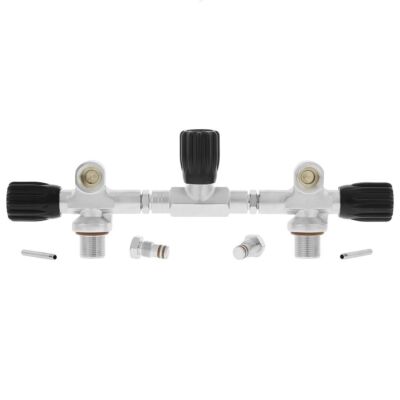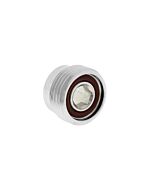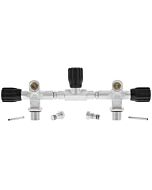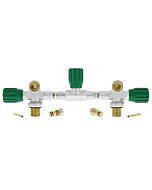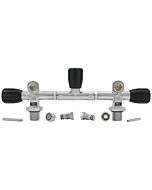DGX Gears Premium Dual-Outlet Manifold with Isolator
- Left and Right modular valves w/ isolation crossbar
- 8.5-inch adjustable center-to-center spacing
- Nitrox Ready - Chromed Brass Construction
- Standard 0.750-14 NPSM (3/4 NPS) neck threads
- Valves have 5250 psi burst disks
DGX Gears Premium Dual-Outlet Manifold with Isolator
The manifold consists of left and right DGX Premium modular valves with an isolation crossbar offering 8.5-inch adjustable center-to-center spacing that perfectly fits any diameter scuba cylinders using standard tank bands. The modular barrel design connectors incorporate double O-ring seals known for their robust reliability. The valves come with 5250 psi burst disks, standard 3/4" NPS neck threads that fit all modern U.S. scuba cylinders, and are Nitrox Ready. The valves have DIN outlets that can accept optional removable inserts (sold separately) so the valves may be used with yoke connectors. You may see this style of outlet variously described as Pro, 200-Bar DIN (G 5/8 BSP), or 232-Bar DIN. Also includes the port plugs so you can reconfigure your doubles as left and right singles if the need arises.
How to Assemble Double Cylinders
| Brand | DGX Gears |
|---|---|
| SKU | DX-722450 |
| Weight | 5.250000 |
Customer Reviews
YOU MAY ALSO BE INTERESTED IN THE FOLLOWING PRODUCT(S)
Manifold Crossbar Isolator Valves May Not Improve Safety
The use of an isolator valve on the manifold cross bar of doubles is a relatively recent introduction in the sport, but their use is now nearly universal in technical diving performed in North America. The idea is that the effect of catastrophic containment failure in the gas path on one cylinder (i.e. burst disk or neck o-ring failure) can be 'isolated' from the other cylinder by closing the crossbar valve.
Very early manifold designs did not have isolator valves and used joints that were face style using metal-to-metal or single o-ring seals. Diving in overhead environments might result in a hard impact directly on on the crossbar and the impact could cause a seal failure with rapid gas loss. The introduction of a third valve in the crossbar itself, termed an isolator valve, was a deemed an improvement in safety. Eventually it became apparent that the barrel style joint with double o-ring seals was far more reliable and today the early manifold designs with face style seals are no longer considered acceptable equipment for technical diving. With modern barrel style double o-ring manifolds, while catastrophic gas loss failures can happen in theory, they are very uncommon and occur nearly exclusively during or within a few minutes after filling. In-water failures on double o-ring design manifolds are more like mermaids; the stuff of legends but reliable accounts of anybody having seen one are rare indeed.
Most divers don't realize that isolator valves are not benign... there have been several accidents directly attributable to isolator valves. That's because isolator valves are notorious for being closed and not getting checked prior to fill operations or during pre-dive preparations. There is a significant body of accidents associated with blending errors caused by closed isolator valves, particularly as mixed gas diving has become increasingly widespread. We've even seen 'near misses' and aborted dives that resulted from valve shutdown drills in which the isolator valve was inadvertently left closed.
With the introduction of double o-ring seals on modern cross bar designs, the safety case for the isolator seems pretty thin. Our advice: while we don't advocate eliminating the isolator valve, we recommend that you never, ever, close your isolator unless you have an emergency. Even so, we've seen well meaning but ignorant fill station operators, divemasters and other individuals needlessly close the isolator valve when the doubles set was outside of the supervision of the diver. Consider using a Vindicator, red handwheel or other kind of indication so you are always reminded to check your isolator valve is open during filling, before gas analysis and just before you get in the water.
